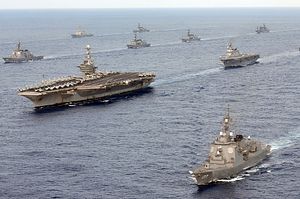As Stephen Stashwick and others have noted at The Diplomat, the U.S. naval lobby has fully embraced Donald Trump’s promise to increase the size of the fleet to 350 ships. Craig Hooper has some ideas about how to get to 350 fast; it would involve putting some prematurely retired ships back into service. Longer term, the U.S. Navy can only grow by slowing retirements and increasing construction, both of which will take some time to have a significant effect on numbers.
But there’s a contradiction.
The U.S. Navy is the primary means through which the United States maintains the liberal international economic order, and one of the primary means through which the United States ensures its global system of alliances. Trump’s commitment to this order is, to say the least, in some doubt. During the campaign he repeatedly questioned the need of the United States to contribute to the defense of its allies in both Asia and Europe. Trump’s statements on international trade also implied little regard for maintaining the global economic order.
In his helpful column on the “Gathering Storm” analysis, Franz-Stefan Gady points out the gulf between demands for 350 (or 450, or 600) ships and serious analysis that takes into account U.S. strategic aims, as well as the capabilities of U.S. adversaries. Given the extant global military balance, the United States does not need 350 ships to defend its territorial integrity. It doesn’t need 250; it doesn’t need 150, it might not need more than 50. Rather, the United States requires a large Navy to perform the obligations that the United States has taken on since 1945, and especially since 1991. These include the protection of allies, the defense of international trade, and (broadly conceived) the protection of international order. These are the very things that Trump has repeatedly expressed minimal regard for.
Unfortunately, the reality of defense investment under Trump may more closely resemble storefront looting than to a serious strategic analysis. Trump has promised to send tons of cash to the Defense Department in order to restore strength and Make America Great Again. Navalists believe that the enduring commitments of the United States require 350 ships, or at least a larger Navy. The strategic incoherence of the Trump administration is both risk and opportunity; if Trump can be convinced that the United States needs 350 ships in order to project strength, then the Navy will get more ships regardless of any disconnect with Trump’s broader conception of America’s place in the world. And if the Navy doesn’t loot the storefront, then someone else will. And when Trump is gone in four or eight years, the ships will still be there to help fulfill the broad demands for U.S. global presence.

































